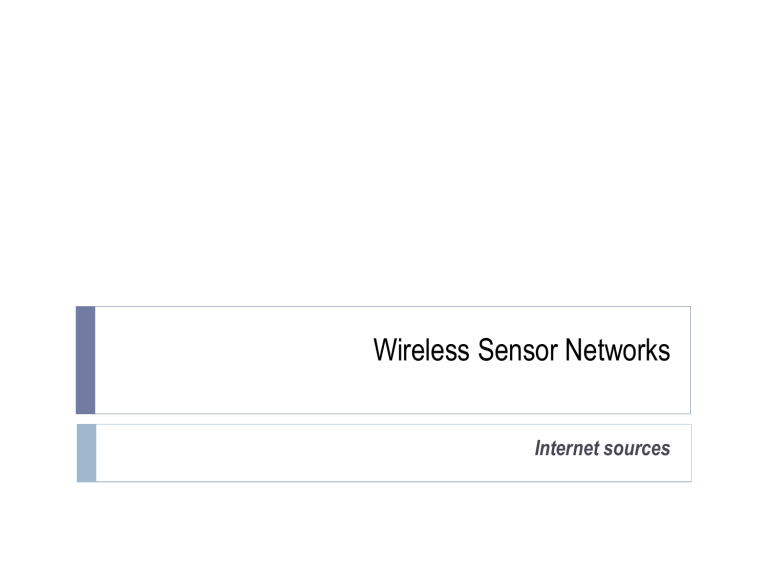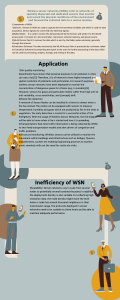
Wireless Sensor Networks Internet sources Wireless Sensor Networks (WSNs) A sensor network is a wireless network that consists of thousands of very small nodes called sensors. Base station Architecture of wireless sensor networks Outline Introduction Wireless Sensor Networks Applications Factors Influencing Sensor Network Design Sensor Node Components Sensor Networks Communication Architecture Sensor Network Protocols Sensor Networks Operating Systems Sensor Networks Simulators Conclusion Introduction Wireless Sensor Networks are networks that consists of sensors which are distributed in an ad hoc manner. These sensors work with each other to sense some physical phenomenon and then the information gathered is processed to get relevant results. Wireless sensor networks consists of protocols and algorithms with self-organizing capabilities. Sensor network Large networks of simple sensors Usually deployed randomly Very prone to failures Use broadcast paradigms to communicate with other sensors Collect information and send it to base station Must focus on power conservation, instead of QoS. Energy=distance2 sensor sensor node A transducer converts physical phenomenon e.g. heat, light, motion, vibration, and sound into electrical signals basic unit in sensor network contains on-board sensors, processor, memory, transceiver, and power supply sensor network consists of a large number of sensor nodes nodes deployed either inside or very close to the sensed phenomenon Wireless Sensor Networks Applications Military Applications Monitoring friendly forces, equipment, and ammunition Battlefield surveillance Reconnaissance of opposing forces and terrain Targeting Battle damage assessment Nuclear, biological, and chemical attack detection Wireless Sensor Networks Applications Environmental Applications Forest fire detection Bio-complexity mapping of environment Flood detection Precision Agriculture Air and water pollution Wireless Sensor Networks Applications Health Applications Telemonitoring of human physiological data Tracking and monitoring doctors and patients inside a hospital Drug administration in hospitals Wireless Sensor Networks Applications Home and Office Applications Home and office automation Smart environment Wireless Sensor Networks Applications Automotive Applications Reduces wiring effects Measurements in chambers and rotating parts Remote technical inspections Conditions monitoring e.g. at a bearing Wireless Sensor Networks Applications Automotive Applications Wireless Sensor Networks Applications Other Commercial Applications Environmental control in office buildings (estimated energy savings $55 billion per year!) Interactive museums Detecting and monitoring car thefts Managing inventory control Vehicle tracking and detection Factors Influencing WSN Design Fault tolerance Scalability Production costs Hardware constraints Sensor network topology Environment Transmission media Power Consumption Sensing Communication Data processing Sensor Nodes Worldsen Inc. Sensor Node Crossbow Sensor Node Sensor Node Components Sensor Node Components Sensing Unit Processing Unit Transceiver Unit Power Unit Location Finding System (optional) Power Generator (optional) Mobilizer (optional) WSN Communication Architecture 18 A Few WSN Protocols Sensor management protocol Sensor query and data dissemination protocol Provides software operations needed to perform administrative tasks e.g. moving sensor nodes, turning them on an off Provides user applications with interfaces to issue queries and respond to queries Sensor query and tasking language (SQTL) Directed diffusion Sensor MAC (S-MAC) IEEE 802.15.4 19 WSN Development Platforms Crossbow Dust Networks Sensoria Corporation Ember Corporation Worldsens 20 WSN Simulators NS-2 GloMoSim OPNET SensorSim J-Sim OMNeT++ Sidh SENS WSN Emulators TOSSIM ATEMU Avrora EmStar WSNs Applications WSNs Applications WSN Applications Wide area monitoring tools supporting Scientific Research Military Applications Wild life Habitat monitoring projects Great Duck Island (UCB), James Reserve (UCLA), ZebraNet (Princeton. Building/Infrastructure structure study (Earthquake impact) Shooter Localization Perimeter Defense (Oil pipeline protection) Insurgent Activity Monitoring (MicroRadar) Commercial Applications Light/temperature control Precision agriculture (optimize watering schedule) Asset management (tracking freight movement/storage) Applications of Wireless Sensor networks The applications can be divided in three categories: 1. Monitoring of objects. 2. Monitoring of an area. 3. Monitoring of both area and objects. Monitoring Objects Structural Monitoring Eco-physiology Condition-based Maintenance Medical Diagnostics Urban terrain mapping Monitoring Area Environmental and Habitat Monitoring Precision Agriculture Indoor Climate Control Military Surveillance Intelligent Alarms Example: Precision Agriculture • Precision agriculture aims at making cultural operations more efficient, while reducing environmental impact. • The information collected from sensors is used to evaluate optimum sowing density, estimate fertilizers and other inputs needs, and to more accurately predict crop yields. Monitoring Interactions between Objects and Space Wildlife Habitats Disaster Management Emergency Response Ubiquitous Computing Asset Tracking Health Care Senor Network/Great Duck Island 2003 Vanderbuilt’s Shooter Localization Characteristics of Wireless Sensor Networks Wireless Sensor Networks mainly consists of sensors. Sensors are low power limited memory energy constrained due to their small size. Wireless networks can also be deployed in extreme environmental conditions and may be prone to enemy attacks. Although deployed in an ad hoc manner they need to be self organized and self healing and can face constant reconfiguration. Design Challenges Heterogeneity Distributed Processing The algorithms need to be centralized as the processing is carried out on different nodes. Low Bandwidth Communication 32 The devices deployed maybe of various types and need to collaborate with each other. The data should be transferred efficiently between sensors Introduction to Wireless Sensor Networks Continued.. Large Scale Coordination Utilization of Sensors The sensors need to coordinate with each other to produce required results. The sensors should be utilized in a ways that produce the maximum performance and use less energy. Real Time Computation The computation should be done quickly as new data is always being generated. Operational Challenges of Wireless Sensor Networks Energy Efficiency Limited storage and computation Low bandwidth and high error rates Errors are common Wireless communication Noisy measurements Node failure are expected Scalability to a large number of sensor nodes Survivability in harsh environments Enabling Technologies Embed numerous distributed devices to monitor and interact with physical world Network devices to coordinate and perform higher-level tasks Embedded Networked Control system w/ Small form factor Untethered nodes Sensing Exploit collaborative Sensing, action Tightly coupled to physical world Exploit spatially and temporally dense, in situ, sensing and actuation Future of WSN Smart Home / Smart Office Sensors controlling electrical devices in the house. Better lighting and heating in office buildings. The Pentagon building has used sensors extensively. Biomedical / Medical Health Monitors Chronic Diseases Glucose Heart rate Cancer detection Artificial retina Cochlear implants Hospital Sensors Monitor vital signs Record anomalies Military Remote deployment of sensors for tactical monitoring of enemy troop movements. 38 Introduction to Wireless Sensor Networks Industrial & Commercial Numerous industrial and commercial applications: Agricultural Crop Conditions Inventory Tracking In-Process Parts Tracking Automated Problem Reporting Theft Deterrent and Customer Tracing Plant Equipment Maintenance Monitoring Traffic Management & Monitoring Future cars could use wireless sensors to: ⚫ ⚫ ✓Sensors embedded in the roads to: –Monitor traffic flows –Provide real-time route updates Handle Accidents Handle Thefts References http://web2.uwindsor.ca/courses/cs/aggarwal/cs60520/SeminarMaterial/WSN-future.ppt http://web.cecs.pdx.edu/~nbulusu/talks/grace-hopper.ppt http://web.cecs.pdx.edu/~nbulusu/talks/grace-hopper.ppt http://galaxy.cs.lamar.edu/~bsun/wsn/wsn.html www.dsc.ufcg.edu.br/~maspohn/katia/introduction.ppt http://computer.howstuffworks.com/mote1.htm http://www.polastre.com/papers/polastre-thesis-final.pdf Alec Woo’s dissertation (Chapters 1-2) http://www.cs.berkeley.edu/~awoo/thesis.pdf Networking of Sensor System (NOSS) workshop presentations CACM WSN special issue, Vol. 47, Issue 6, June 2004. (this url required uccs vpn access) The platforms enabling wireless sensor networks, by Jason Hill et al.




